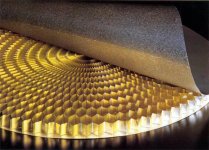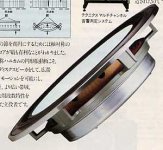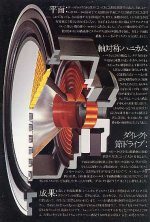hi l have these speakers
hi these are great sounding speakers well l think so
there 3 ways mine are sbx - 70 model
l brought them of ebay hard to get here in new zealand.
there was sb-x 50 model as well just slighty smaller woffers
from memory they came out in like 1985
l recomend u getitng hold a pair very clear sound maybe little heavy on the bass but exellent sound
hi these are great sounding speakers well l think so
there 3 ways mine are sbx - 70 model
l brought them of ebay hard to get here in new zealand.
there was sb-x 50 model as well just slighty smaller woffers
from memory they came out in like 1985
l recomend u getitng hold a pair very clear sound maybe little heavy on the bass but exellent sound
interesting thread and clever honeycomb technology
I wonder why it has been discontinued?
here is a set of MLSSA measurements of Technics SB-7 (smaller brother of abovementioned SB-10):
http://www.real-audio.ru/measurements/msm/loudspeakers/sb7.html
very nice measurements
energy-time curves look particularly impressive (curves under 4 and 11)
I can understand why they were said to be "exceptionally fast"
here is the whole "family" of flat honeycomb Technics:
http://www.audio-heritage.jp/TECHNICS/speaker/index2.html
one of the real "monsters":
http://www.audio-heritage.jp/TECHNICS/speaker/sb-m1.html
I wonder why it has been discontinued?
here is a set of MLSSA measurements of Technics SB-7 (smaller brother of abovementioned SB-10):
http://www.real-audio.ru/measurements/msm/loudspeakers/sb7.html
very nice measurements
energy-time curves look particularly impressive (curves under 4 and 11)
I can understand why they were said to be "exceptionally fast"
here is the whole "family" of flat honeycomb Technics:
http://www.audio-heritage.jp/TECHNICS/speaker/index2.html
one of the real "monsters":
http://www.audio-heritage.jp/TECHNICS/speaker/sb-m1.html
Attachments
Going back to the beginning of this thread, I have a set of the wall mounting speakers (SB-50, I think, I'll have to unpack them to see). They are about 12" square and 3" thick, basically the same form factor as the Technics SL-10 turntable (the 12" square, linear tracking arm model).
The drivers are concentric: The centre is a tweeter with a slotted grille design like a B&K measuring microphone. It was used in several Technics models. The next diaphragm is a bass/midrange. It forms a ring around the tweeter, with two surrounds - one on the inside edge and one on the outside of the ring diaphragm. The voice coil is mounted directly on the back of the diaphragm and the magnet assembly is ring shaped. The outermost diaphragm is a passive radiator (ABR or "drone cone").
As has been pointed out, the flat diaphragm technology was used in more conventional cabinet styles as well, with separate bass / mid / tweeter.
The top line flat diaphragm bass drivers used the technique of mounting a large diameter voice coil directly on the diaphragm about half way between the centre and the edge, and used a large ring shaped magnet assembly. Thr cheaper bass drivers used a conventional voice coil assembly, with a short cone connecting the voice coil to the back of the diaphragm at the "half way" position. In both cases, the design was intended to apply the driving force at the midpoint of the diaphragm to reduce bending forces that would be caused by attaching a small voice coil to the centre of the diaphragm.
The drivers are concentric: The centre is a tweeter with a slotted grille design like a B&K measuring microphone. It was used in several Technics models. The next diaphragm is a bass/midrange. It forms a ring around the tweeter, with two surrounds - one on the inside edge and one on the outside of the ring diaphragm. The voice coil is mounted directly on the back of the diaphragm and the magnet assembly is ring shaped. The outermost diaphragm is a passive radiator (ABR or "drone cone").
As has been pointed out, the flat diaphragm technology was used in more conventional cabinet styles as well, with separate bass / mid / tweeter.
The top line flat diaphragm bass drivers used the technique of mounting a large diameter voice coil directly on the diaphragm about half way between the centre and the edge, and used a large ring shaped magnet assembly. Thr cheaper bass drivers used a conventional voice coil assembly, with a short cone connecting the voice coil to the back of the diaphragm at the "half way" position. In both cases, the design was intended to apply the driving force at the midpoint of the diaphragm to reduce bending forces that would be caused by attaching a small voice coil to the centre of the diaphragm.
Don Hills said:
The top line flat diaphragm bass drivers used the technique of mounting a large diameter voice coil directly on the diaphragm about half way between the centre and the edge, and used a large ring shaped magnet assembly.
as in Technics SB-M1:
Attachments
Don Hills said:
Thr cheaper bass drivers used a conventional voice coil assembly, with a short cone connecting the voice coil to the back of the diaphragm at the "half way" position.
as in Technics SB-10:
Attachments
Graaf,
That is exactly what I meant. Thank you. Note also that the image for the SB-M1 shows how attaching the voice coil about half way out from the centre, rather than at the edge (or at the middle), reduces the flexing of the diaphragm.
The driver in the "wall mount" speakers looks similar to the M1 but has a hole in the middle of the diaphragm with an inner surround, and the tweeter is mounted in the hole.
That is exactly what I meant. Thank you. Note also that the image for the SB-M1 shows how attaching the voice coil about half way out from the centre, rather than at the edge (or at the middle), reduces the flexing of the diaphragm.
The driver in the "wall mount" speakers looks similar to the M1 but has a hole in the middle of the diaphragm with an inner surround, and the tweeter is mounted in the hole.
Bump and flat aluminum resurrection?
I just noticed that a few makers have started putting out flat-disc "aluminum sandwich" drivers again in the past year or so. I've been watching for old undamaged Technics drivers on eBay for a while, I never expected to pop over to PartsExpress to see what was on clearance and see a full line of familiar looking drivers... wearing a TangBand label. ADI (formerly Adire?) also has a new "Horizon 100" flat aluminum driver.
The TB full-ranges look especially interesting. The lack of any apparent breakup on the claimed response charts would seem to suggest these might be faithful imitators... anyone know about them?
[edit: oops, some model numbers might be useful. I was looking at the TB W3-1797S, W4-1757SB and 1798S over at PE]
[another edit: damn, I see now it's a uniform honeycomb. Drat.]
I just noticed that a few makers have started putting out flat-disc "aluminum sandwich" drivers again in the past year or so. I've been watching for old undamaged Technics drivers on eBay for a while, I never expected to pop over to PartsExpress to see what was on clearance and see a full line of familiar looking drivers... wearing a TangBand label. ADI (formerly Adire?) also has a new "Horizon 100" flat aluminum driver.
The TB full-ranges look especially interesting. The lack of any apparent breakup on the claimed response charts would seem to suggest these might be faithful imitators... anyone know about them?
[edit: oops, some model numbers might be useful. I was looking at the TB W3-1797S, W4-1757SB and 1798S over at PE]
[another edit: damn, I see now it's a uniform honeycomb. Drat.]
Last edited:
Getting back to honeycomb information
I'm in an interesting position where I don't need drivers to listen to, I need them for instrumentation; as perfect a piston as possible and the honeycombs look like they might have been the best practical approximation for a given range. Finding something I can buy, no matter how rare, is [probably] easier on the research budget than building something from scratch.
I've found one supplier of an unknown Technics 5" honeycomb midrange and ordered a pair (they look to be the metal cone behind a honeycomb plate variety):
EAS-14PL43S
5.25” Technics Flat Aluminum Cone Shielded Woofer
...and I also snagged a reasonably priced pair of vintage honeycomb tweets off eBay. No idea what exactly they are, they're not here yet.
Panasonic apparently still stocks/sells some NOS driver units if you have the correct part number handy... might anyone be willing to check and offer up the part numbers on the drivers in their complete speaker units?
Also, since I've got a (hand-built/untested) laser triangulation mapping jig here I'm itching to try out, I'm hoping it works well enough to map cone breakup and compare directly against one of the new Tang Band drivers.
I'm in an interesting position where I don't need drivers to listen to, I need them for instrumentation; as perfect a piston as possible and the honeycombs look like they might have been the best practical approximation for a given range. Finding something I can buy, no matter how rare, is [probably] easier on the research budget than building something from scratch.
I've found one supplier of an unknown Technics 5" honeycomb midrange and ordered a pair (they look to be the metal cone behind a honeycomb plate variety):
EAS-14PL43S
5.25” Technics Flat Aluminum Cone Shielded Woofer
...and I also snagged a reasonably priced pair of vintage honeycomb tweets off eBay. No idea what exactly they are, they're not here yet.
Panasonic apparently still stocks/sells some NOS driver units if you have the correct part number handy... might anyone be willing to check and offer up the part numbers on the drivers in their complete speaker units?
Also, since I've got a (hand-built/untested) laser triangulation mapping jig here I'm itching to try out, I'm hoping it works well enough to map cone breakup and compare directly against one of the new Tang Band drivers.
- Status
- Not open for further replies.
- Home
- Loudspeakers
- Multi-Way
- HoneyComb Speakers


